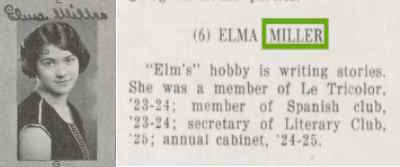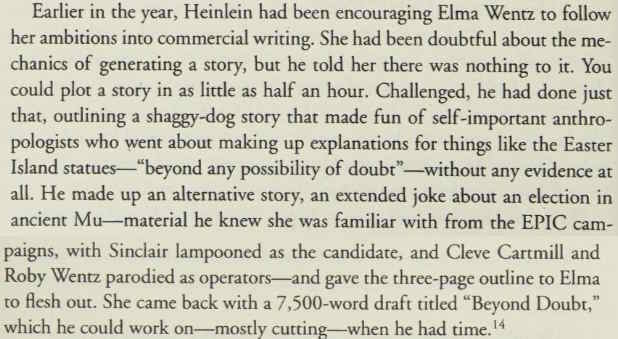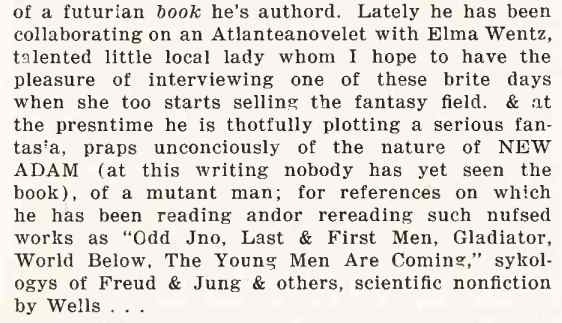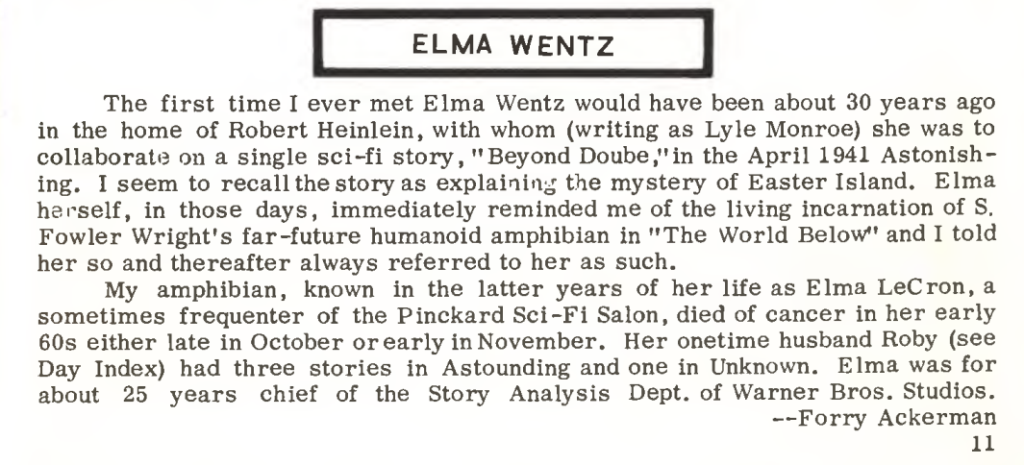I’ve been reading for a planned post on time travel tourism. One of the stories from Michael Main’s Internet Time Travel Database that might feature time travel tourism was “Pawley’s Peepholes” by John Wyndham, a short story from the fall 1951 Science Fantasy.
Looking for that story, I found it was reprinted almost immediately in Frederik Pohl’s 1952 “Beyond the End of Time” anthology on Permabooks. I have that book, although it is falling apart! I probably purchased it in the early 1970s, and have not read it since then. I will reread it eventually, but a quick scan of the Table of Contents reveals an interesting mix of stories, with some absolute classics such as C. M. Kornbluth’s 1950 novelette “The Little Black Bag“, Cordwainer Smith’s 1950 novelette “Scanners Live in Vain” and Ray Bradbury’s 1950 short story “There Will Come Soft Rains“, and others I am not at all sure about.
After reading “Pawley’s Peepholes”, I noticed a story by Robert A. Heinlein (as “Lyle Monroe”) and Elma Wentz, “Beyond Doubt“, from the April 1941 Astonishing Stories.
I know I’ve read this story in “Beyond the End of Time” at least once, but I remember nothing about it or even that it existed until seeing this. I found this very interesting for several reasons:
- To my knowledge, this is the only fiction published by Heinlein with a co-author during his lifetime.
- Heinlein clearly was not fond of it, as he never allowed this and two of his other early stories published as by “Lyle Monroe” to be reissued in a Heinlein collection during his lifetime (per Wikipedia).
- I had no idea who “Elma Wentz” was.
Given what I know about “Beyond Doubt”, I have questions about how good it is. I will reread it before I publish this post, and circle back with my thoughts.
Regardless, I wanted to know more about Elma Wentz. I checked for her entry at the Internet Speculative Fiction Database (ISFDB), as it’s perhaps the most important of my go-to resources for speculative fiction information. When I first checked it, the only facts noted for her entry were:
- Her name, “Elma Wentz”.
- Language listed as “English”.
- She is one of the authors of “Beyond Doubt”, published first in the April 1941 issue of Astonishing Stories with Robert A. Heinlein as the other author.
This was about as little information in ISFDB as could exist on anyone with a published story. ISFDB is a user created/edited speculative fiction resource, so any entries are because someone thought they were worth making or improving and that someone knew something pertinent in a hopefully reliable and authoritative fashion. I found nothing on Elma Wentz in the Science Fiction Encyclopedia (www.sfe.com) or any other obvious sites.
This paucity of information made me think that either a) no one knew anything, b) no one cared enough who knew anything, or c) no one had gotten around to working on this issue.
I also wondered if this situation would have been the case if the less well known author had been a man. In my adventures on family history and my family tree development, I have unfortunately encountered all too often where the only thing that could be known for sure about a female ancestor or relative was that they had lived and were recorded as a “Mrs. Smith” married to Mr. John Smith, with their first name noted when I was lucky. This was fairly common up to some time in the 1800s for my family.
Especially given that this story was published in 1941 and that one of the co-authors, Robert A. Heinlein, was one of the pre-eminent science fiction authors for a number of decades, I felt it was worth looking into and seeing if I could do anything to both improve the ISFDB entry and to make Elma Wentz more known. At the very least, I wanted to get to what I consider the minimum ISFDB information on any author, which is birth date and place, death date, and perhaps birth name in the Notes if the last name is a married name.
I did some research online, both using Google, Ancestry.com, and Newspapers.com, and I think I have established a number of facts and information on some of the arcs of her life. I was lucky enough to be able to find a relative of Elma, who hooked me up with those that knew her. A tip of the hat to the Miller family for their gracious help.
Elma Wentz was born Elma Langhorne Miller on December 12, 1906, in Tacoma, Washington, to lumber broker Lynn Holmes Miller and his wife Lillian Rhea (Langhorne) Miller. The 1930 US federal census shows her living with her family, single and with no occupation at age 23 in Seattle.
She was quite musical, according to her family. To quote them, “She had a very musical ‘ear’ – she could recreate a piece of music from hearing it once or twice and play it on the piano. In fact, she sometimes accompanied silent movies, before ‘talkies’, by supplying the background drama and musical ‘punctuation’ in a Seattle theater.” One theatre in Seattle started presenting full talkies in January 1929; it’s likely that Elma’s accompaniment of silent movies occurred at or before this time.

Her high school senior yearbook, “The Tahoma”, for the Stadium High School class of 1925 in Tacoma, WA, noted her hobby as “writing stories”.
She attended the University of Washington, perhaps finishing in 1931. She stayed in touch with Professor Garland Ethel, who taught in the English department from 1927 to 1969. I assume that she took English with him.
Sometime in the early 1930s, she moved to Los Angeles. Her family did also, although it’s not clear if they moved at the same time or not.
William H. Patterson, Jr.’s “Robert A. Heinlein: In Dialogue with His Century: Volume 1: 1907-1948: Learning Curve” (“Robert A. Heinlein: In Dialogue…”), 2010 Tor, noted that Elma was working for Upton Sinclair on Sinclair’s California 1934 governor’s campaign as his personal secretary. Patterson also notes that she and her husband to be, Roby Wentz, met Robert A. Heinlein when Heinlein joined Sinclair’s related “End Poverty in California” (EPIC) movement in early 1935. The EPIC movement overlapped substantially with Sinclair’s run for governor. This resulted in her and Roby becomes friends with Robert A. Heinlein and his first wife Leslyn (MacDonald) Heinlein, and with journalist (and future SF writer) Cleve Cartmill.

Elma married her first husband, John Roby (also noted as “Roby” or “Robie” in some places) Wentz in Los Angeles on October 27, 1937.
In 1938, Robert A. Heinlein ran for the State Assembly in the 59th District in what is currently South Los Angeles as a Democratic candidate. He asked Roby Wentz to manage his campaign.

It’s worth noting that Heinlein and Elma Wentz had common interests in occult and esoteric matters, as noted on Page 203 above.
As stated on the Wikipedia End Poverty in California webpage, Heinlein then went into writing science fiction to pay off campaign debts after his losing Assembly campaign and to support his family. Heinlein began attempting to put a book or story together, titled “For Us, The Living“, which was not published until 2004, many years after his death.
At that point, Heinlein felt he could do a bit more research into writing and markets and the business of writing.

Heinlein gave Elma encouragement and the start on a story with a three-page outline for a story in early 1939. She came back with a 7,500 word draft she titled “Beyond Doubt”.

Heinlein felt that it needed editing, mostly cutting. He sent it to John W. Campbell, Jr., (for “Unknown” I assume, given that “Beyond Doubt” features magic and quacks like a fantasy to me), and others, who all rejected it.
In the November 1939 “Ad Astra” fanzine (Volume 1 #4), Western correspondent “Farwest” Jack Erman’s column mentions one of the Heinlein weekend get-togethers and Elma.

The column reports that Elma was working at Hal Roach Studios, with the production of the 1940 science fiction film “One Million BC” mentioned.
For the 1940 US federal census, Elma and Roby Wentz are shown as living southeast of Hollywood and west of Silverlake in Los Angeles. Elma was listed as a “secretary” and Roby as a “writer”. In “The Complete Works of Robert A. Heinlein: The Virginia Edition” (“The Complete Works…”), a 2010 limited edition, the segment on “Beyond Doubt” has a very informative two page entry about the writing and publishing of “Beyond Doubt”. The “About The Series” essay in “The Complete Works…” states, “Each volume includes a frontispiece photograph of the Heinleins as well as an introduction by Dr. Robert James and William H. Patterson, Jr., Heinlein Scholar, detailing the circumstances under which each work was written.” With that, I assume that one or both of them wrote the essay on “Beyond Doubt”.
Forrest J. Ackerman’s “Advance Visions” column in the “Stardust” fanzine for May 1940 (Volume 1 #5) mentions Elma and Robert A. Heinlein and the story that would be published as “Beyond Doubt”:

It appears likely that Roby and Elma attended the Heinlein hosted weekly Saturday night gatherings, which had transitioned from mostly political figures to mostly local science fiction professionals and the occasional local SF fans as the “Mañana Literary Society” . Looking at “Robert A. Heinlein: In Dialogue…”, pages 252 and 253, attendees included Henry Kuttner and his wife C. L Moore, William Anthony Parker White (AKA “Anthony Boucher“), Cleve Cartmill, J. Francis McComas, L. Sprague de Camp, L. Ron Hubbard, Arthur K. Barnes, Leigh Brackett and her husband Edmond Hamilton, Willy Ley, Jack Williamson and a very young and “rambunctious” Ray Bradbury.
In the fall of 1940, as noted in “The Complete Works…”, Heinlein edited “Beyond Doubt” fairly substantially, cutting perhaps a third of it and restructuring it for publication in Frederik Pohl‘s “Astonishing Stories” in April 1941. I enjoyed this amusing story of political machinations and campaigning in ancient Mu, a fantasy that was doubtlessly influence by the time both Robert A. Heinlein and Elma Wentz spent in political campaigns. It’s a story of what could have been the ancient version of political cartooning with statues of a Mu politician nicknamed “Old Bat Ears”, with a great Hannes Bok illustration. Robert A. Heinlein used his pseudonym “Lyle Monroe” for this work, which he felt was not one of his best.

Roby Wentz registered for the draft on October 16, 1940, with his registration card noting his employer as “Democratic National Committee” and Elma Wentz as his wife. John enlisted in the US military on July 24, 1943. According to Archives West, his World War 2 service was that he, “…served in the United States Army in Europe during World War II. Wentz was an official correspondent with the 70th Infantry in France and Germany.” It appears he served until 1945.
Roby Wentz made his foray into writing fiction with 8 stories published from 1942 to 1947, with sales of science fiction, fantasy and mysteries. The only one I’ve read, “House of Tomorrow” in the May 1944 Astounding, was not very good. I assume Elma continued working as a secretary, in lieu of any other information. “The Complete Works…” states that Elma enjoyed “a modest success” of sales to non-genre magazines known as “the slicks“, which sold to a mainstream, non-genre crowd and usually paid more than genre publications. I was unable to discover anything more specific about these non-genre magazine sales. That does not mean they did not exist, as I can think of a number of reasons for not finding them.
Here is a great family photo of Elma, possibly from the 1940s.

Elma was hired by Warner Brothers to be a “reader” or story analyst in 1946. This is noted in a personal letter from Elma to Professor Garland Ethel dated June 26, 1949, and found in the Pacific Northwest Historical Documents Collection of the University of Washington Libraries. I don’t find this surprising in any way, given her earlier interest in the movies and in telling stories, and considering her earlier job at Hal Roach Studios. It also clearly tells us that she was a person who acted based upon her principles, especially in the context of movie industry labor relations. See excerpt below, which details the start of her career at Warner Brothers and of being out on strike and being jailed for being on strike.

Nat Segaloff, writer and Hollywood historian, was good enough to speculate for me at what a story analyst’s job would consist of in this context.

According to an item in the Nevada State Journal on June 30, 1948, Elma and Roby Wentz had divorced. In the letter to Garland Ethel, she noted, “…after ten years of marriage, my marriage broke up. I don’t know if one should blame the war or not.” She then married psychologist Leslie M. LeCron, as noted in June 26, 1949 letter to Garland Ethel. Elma’s marriage to LeCron ended in December 1954.
Not long after Elma married Leslie M. LeCron, “Beyond Doubt” was reprinted for the first time in Frederik Pohl’s 1952 paperback Permabooks anthology “Beyond the End of Time“. “The Complete Works…” states that Pohl wanted it for it’s lighter, humorous nature compared to some of the more serious works in the TOC. Also, Pohl had published it in Astonishing, so he certainly knew the story. Although “The Complete Works…” noted that this should have been reprinted under her original name of “Elma Miller”, it showed up as by “Elma Wentz” regardless.

Circa 1956, Elma sent a postcard to cousins from Egypt, recounting how much she liked camel riding and her trip up the passageway into the Cheops pyramid.

Soon after that postcard, Elma began a series of periodic visits to Washington to visit relatives. To at least one younger cousin, she was the “celebrity” cousin who was charming, was cool, and smoked! She fanned the flames of imagination for that cousin about the world.
Elma told a story of living in Los Angeles and visiting “…Aldous Huxley’s haunted house.. Apparently as she was descending the stairs for dinner, the lady of the house later told her that she saw superimposed over her another woman descending the stairs dressed in an old gown. Holy Toledo!!” This is not surprising, as Elma had a lifelong interest in the occult and strange.
She helped a family member get over their fear of looking up at starry night skies, with some speculation that she had an interest in UFOs and life on other worlds.
Finally, on one of these visits to family in Washington, she was heard to say, “Thank god for residuals”. It’s not clear if this was in the context of any of her work, or more on the general nature of movie and TV people making enough to live on. This certainly resonates with the current (2023) writers and actor strike.
Clearly, Elma’s interest in speculative fiction and in people continued throughout her life. Fancyclopedia 3 notes that “The Pinckard Salon” (noted in her obituary below) was a series of invitational SF parties in the late 1960s and early 1970s. Another source (Santa Maria Times, Saturday, May 31, 1969) suggests that these “salons” could have started as early as 1963. Either way, Elma continued to enjoy people and science fiction for most of her life.
Elma’s work at Warner Brothers in the Story Analysis Department shows up occasionally to online research. At the Wisconsin Historical Society, there is noted a one page plot description of “The small time”, by Elma L Wentz, 18 February 1948. There is also a one page Reader Synopsis cited of “These many years [Chain lightning]” by Elma LeCron, 19 December 1957. In “Gay Fandom and Crossover Stardom: James Dean, Mel Gibson, and Keanu Reeves“, by Michael DeAngelis, 2001 Duke University Press, her work is cited again:

Elma continued to work for Warner Brothers as a studio story analyst for most and perhaps all of the rest of her life. She died in Los Angeles, on November 1, 1971. The only obituary I found was in the Luna Monthly fanzine, Number 31, December 1971, at http://www.fanac.org, by uber-fan Forrest J. Ackerman, who had known her since at least 1940.

Elma was mentioned in the “In Memorium” feature of the L. A. Con I program book for the 1972, 30th World Science Fiction Convention in Los Angeles, along with other speculative fiction figures who had died since the prior year’s convention. She was definitely known and remembered by them.

“Beyond Doubt” was next reprinted in “Political Science Fiction: An Introductory Reader“, Martin H. (Harry) Greenberg & Patricia S. Warrick editors, 1974 Prentice-Hall. Ten years later, it was reprinted in “Election Day 2084: Science Fiction Stories About the Future of Politics“, Isaac Asimov & Martin H. Greenberg editors, 1984 Prometheus Books. It is interesting that the 1984 reprint did not credit Elma “Miller” Wentz as a coauthor. I have no idea what to make of that, but it was just a few years before Robert A. Heinlein died.
As noted previously, “Beyond Doubt” was not reprinted in a Robert A. Heinlein collection during his lifetime. Finally, in 2005, 17 years after his death, it was reprinted in the Heinlein collection “Off the Main Sequence: The Other Science Fiction Stories of Robert A. Heinlein“, 2005 Science Fiction Book Club, and then in the 2010 Heinlein collection “The Complete Works…”.
My final step on this journey is to update the ISFDB entry to include Elma’s birth name and to update it with the correct birth and death information.
While I did not discover an unknown classic here in “Beyond Doubt”, I am glad that I was able to come up with a reasonably good answer to the question, “Who is Elma Wentz?” Her story is both interesting and more surprising than I was expecting, and she deserves to be known. My thanks again to the Miller family for their gracious help.
Leave a comment